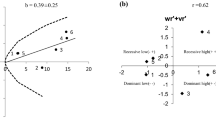Abstract
An investigation was carried out in India, to study the extent of heterosis expressed in single, three-way and double cross hybrids with respect to important economic characters. The results were discussed in terms of relative heterosis (heterosis over mid-parent value) and standard heterosis (heterosis over standard check variety). Significant negative relative heterosis was observed for total larval duration in single and majority of the three-way crosses; whereas it was positive and significant in double cross hybrids. The commercial characters like cocoon and pupal weight, shell percentage, filament length and denier, recorded positive relative heterosis in most of the single and three-way crosses; whereas they were negative and significant in most of the double crosses. In general, higher degree of heterosis was expressed in single crosses followed by three-way and double crosses for the characters studied.
Résumé
Une enquête pour etudier l’importance du degré d’hybridité exprimée chez les hybrides par rapport aux caracteristiques economiques importants chez le ver à soie a étè effectuée en Inde. Les resultats obtenus ont étè analysé en terme d’hybridité relative (hybridité sur la valeur parentale moyenne) et standart (Hybridité sur la verification des varietes). Une hybridité relative d’une valeur negative significative fut observee pendant la durée du developpement larvaire chez le croisement simple et triple contre une hybridité positive et significative chez les souches hybrides resultant d’un croisement double. Les caracteristiques commerciaux par exemple; le poids du cocon, le poids des chrysalides, le pourcentage de la coquille, la longeur et le denier du filament ont enregistré une humidité relative positive chez la majorité des souches hybrides émanant d’un croisement simple et triple contre une valeur significative et negative chez la majorité des hybrides resultant d’un double croisement. En genèral, un degré elèvé d’hybridité a étè exprimé chez le croisement simple suivit du croisement triple et double pour les caracteristiques etudies.
Similar content being viewed by others

References
Anonymous (1976) Dialogue with Dr. Tazima. Indian silk 15, 7–9.
Anonymous (1985) Silkworm Breeding and Genetics Section. Annual Report, Central Sericultural Research and Training Institute, Mysore, India,pp. 1–20.
Chaudhary B. S., Paroda R. S. and Singh V. P. (1978) Stability and genetic architecture of harvest index in wheat (Triticum aestivum L..) Z. pfl. 81, 312–318.
Datta R. K. (1984) Improvement of silkworm races (Bombyx mori L.) in India. Sericologia 24, 393–415.
Harada C. (1952a) On the double cross of the silkworms. Japan. J. Breed. 2, 3.
Harada C. (1952b) On the three-way cross of the silkworms. Japan J. Breed. 3, 99.
Krishnaswami S., Narasimhanna M. N., Suryanarayana S. K. and Kamaraj S. (1973) Silkworm rearing. Manual on Sericulture, Vol. 2. FAO of UN, Rome, p. 131.
Pannegpet, P., (1973). Survey on the practical characters of three-way cross and double cross hybrids of bivoltine silkworm races. Bull. Thai Sericultural Research And Training Centre, Thailand 3, 81–82.
Pannegpet P. and Jaroonchai J. (1975) Survey on practical characters of double cross hybrids of bivoltine silkworm races (2). Bull. Thai Sericultural Research And Training Centre, Thailand 5, 85–86.
Rai B. (1979) Heterosis Breeding. Agrobiological Publications, Delhi, p. 183.
Yokoyama T. (1974) Utilization of heterosis in Japanese Sericulture (SABRAO Proa). Indian J. Genet. 34A, 206–210.
Author information
Authors and Affiliations
Rights and permissions
About this article
Cite this article
Udupa, S.M., Visweswara Gowda, B.L. Heterosis in Single, Three-way and Double Cross Hybrids of Silkworm, Bombyx mori L.. Int J Trop Insect Sci 9, 519–525 (1988). https://doi.org/10.1017/S1742758400011073
Received:
Revised:
Published:
Issue Date:
DOI: https://doi.org/10.1017/S1742758400011073
Key Words
- Bombyx mori
- heterosis
- single cross hybrids
- three-way cross hybrids
- double cross hybrids
- cocoon characters



